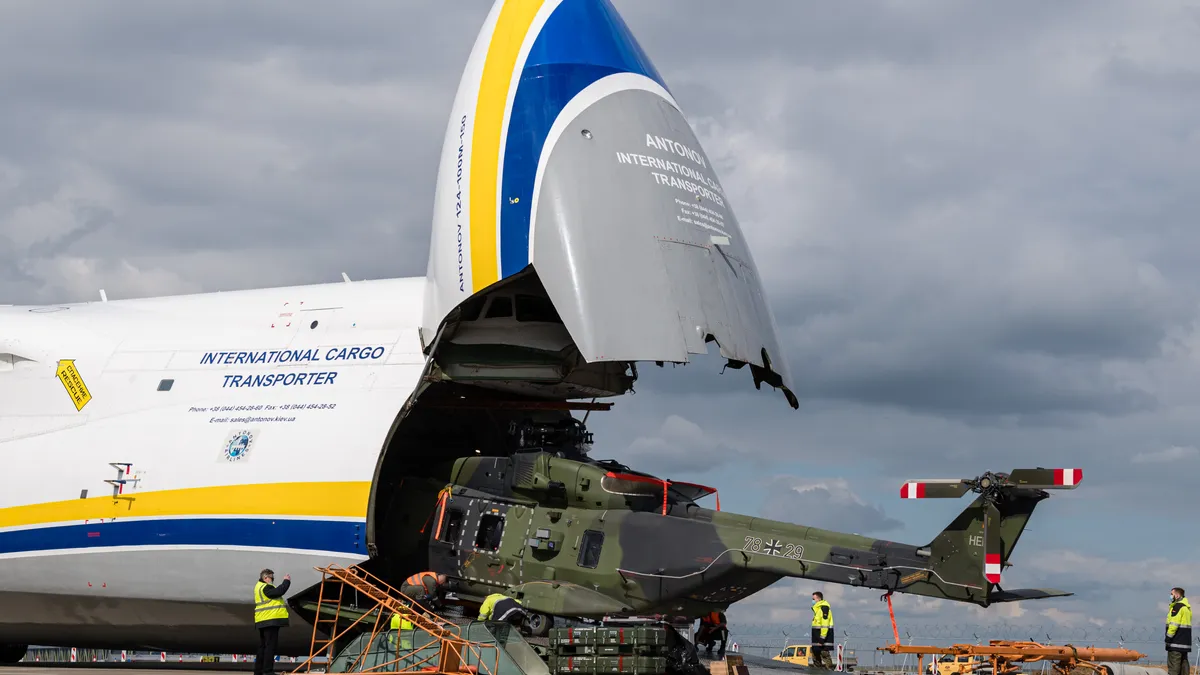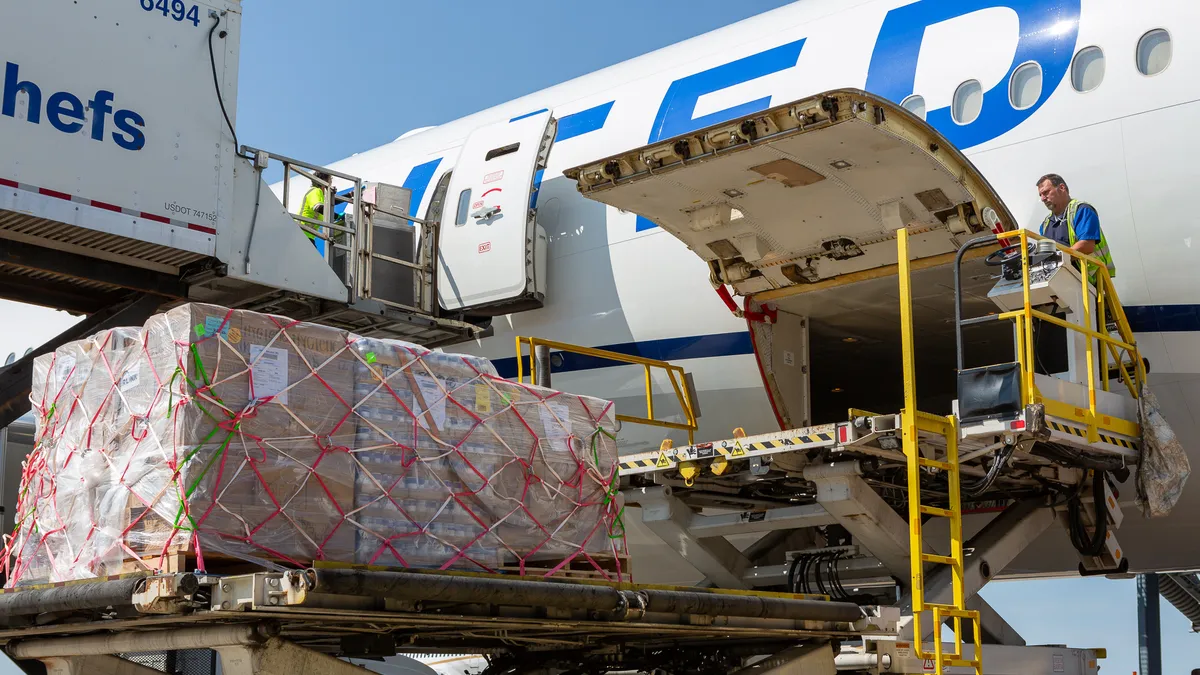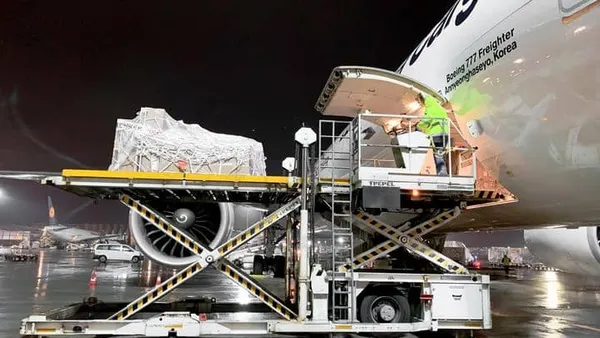Airspace restrictions due to the war in Ukraine could further limit options for shippers looking to transport large cargo.
The United States joined the European Union and Canada in closing its airspace to aircraft from Russia on Wednesday. The Department of Transportation order suspends foreign air carriers based in Russia from operating scheduled passenger and all-cargo air services to and from the U.S. This includes services from Russia's largest airline Aeroflot and all-cargo carrier AirBridgeCargo Airlines.
These restrictions add further pressure to an already tight airfreight market.
AirBridgeCargo "is a major player on the North East Asia to Europe tradelane," Niall van de Wouw, Chief Airfreight Officer of Xeneta, said in an email. It ranked 16th in cargo traffic in 2020, according to the International Air Transport Association, and offers a fleet of 18 Boeing freighters.
Boeing freighters are a mainstay in air cargo transport, but AirBridgeCargo parent company Volga-Dnepr Group also has something few other carriers can offer: the ability to ship extra large and bulky freight. Its fleet includes 12 AN-124s and five IL-76s, both of which have heavy transport capabilities.
"Russian carriers have operated in the US in the past but their loss will not significantly impact air cargo capacity in the long run except in the movement of oversize/outsized cargo," said Ben Skipper, executive director of aerospace and defense programs at the University of Tennessee-Knoxville, in an email. "The loss of the Russian and [Ukrainian] commercial fleets including AN-225, AN-124s and IL-76s could be problematic in the short run."
How Russia's invasion is lowering bulky aircraft capacity
Heavy-lift aircraft availability was further strained on Sunday, when forces from Russia reportedly destroyed Antonov Airline's AN-225 during an airfield invasion.
Ukraine-based Antonov Airlines said Thursday the aircraft's condition cannot be confirmed until expert inspection. If confirmed, it would leave Antonov without the world's largest aircraft.
The airline is also one of the few non-military AN-124 operators outside of the Volga-Dnepr Group — only 26 civilian models are in operation, according to Euroasian Cargo Solutions.
Many of those planes have been grounded since the war began, though. Ten of Antonov's 15 jets last landed in Kiev, Ukraine, Flexport Supply Chain Economist Chris Rogers wrote in a blog post, citing a company analysis of Flightradar24 data. The remainder have landed in Europe or the U.S. No upcoming flights were listed for Antonov Airlines on Flightradar24 as of Friday.
"The destruction / grounding of the world's Antonov fleet will render oversized project cargo shipping by air impossible, imposing major costs and delays on a huge range of industries, most notably the energy sector," Flexport CEO Ryan Petersen said in a Twitter thread.
The AN-124's capabilities to handle extra bulky and oversized loads are important for shippers in the engineering and aerospace industries.
How the AN-124 compares to a Boeing 747
| Boeing 747-400F | Antonov AN-124 | |
|---|---|---|
| Payload | 264,554 lbs | Up to 330,693 lbs |
| Hold size | 1,889" x 191" x 119" | 1,436" x 251" x 173" |
| Door Size | 133" x 122" | 251" x 173" |
SOURCE: Air Charter Service
Antonov Airlines recently used one of its AN-124 aircraft to transport a Turkish communications satellite from France to the U.S. that was launched by SpaceX in December. Antonov used special equipment designed and manufactured in-house to help load and unload the satellite's container.
In February, the U.S. Department of Transportation granted the Volga-Dnepr Group a foreign air carrier exemption to operate five one-way, all-cargo charter flights on AN-124 aircraft for Boeing. Boeing needed the flights to quickly ship outsized aircraft parts, components and engines to avoid production delays, according to a DOT document.
In granting its approval, the DOT "concluded that no U.S. carrier had aircraft available that could be used to conduct the operations at issue here."
Flight times rise as airlines circumvent Russia
For other airlines, Russia's invasion of Ukraine has created longer transit times as they reroute flights between Europe and Asia to avoid the airspace.
In the five days ending Feb. 28, average flight times on six key trade routes from Asia to Northern Europe increased by 3.4% compared to the Dec.1 to Feb. 22 period, Rogers wrote.
Some carriers may cancel their Asia-Europe services as they face longer and costlier routes, Freightos Group Head of Research Judah Levine said in a weekly update on Thursday. Carriers who continue to fly will pass on higher fuel costs to cope with the longer routes, while the additional fuel could limit the amount of cargo carried, Levine added.
"These multiple factors reducing capacity and increasing costs for shippers were already reflected in climbing Asia-Europe air cargo rates at the end of last week," Levine said.
Air shippers have already been weathering higher rates as the COVID-19 pandemic sparked a drop in air cargo capacity. The month of February was a step in the right direction, as volumes and capacity both stabilized close to pre-pandemic levels and rates trended downward, according to a Clive Data Services news release. But Van de Wouw said the war in Ukraine presents a new layer of uncertainty.
"It all depends how long (these) sanctions and the responses thereto will remain in place - but if they are here to stay for months to come then it should surely have a profound impact," he said.















